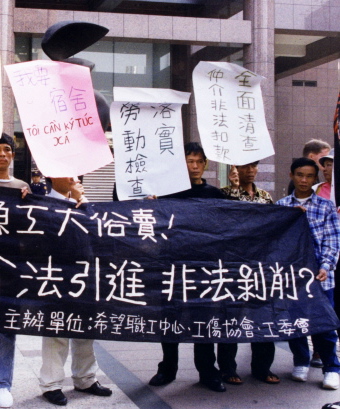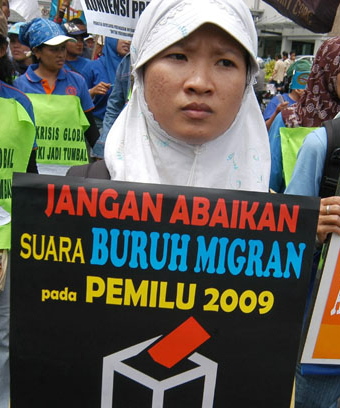A ‘waria’ version of the traditional flag ceremony celebrates both nationhood and diversity
Diego García Rodríguez
The day before 17 August, when Indonesia celebrates its independence, I got a WhatsApp message from Bu Shinta reminding me to attend her upacara bendera, or flag ceremony. She is a waria (roughly translated as transgender woman), and leader of the only Islamic boarding school for waria in the world, Pondok Pesantren Waria Al-Fatah in Yogyakarta. Bu Shinta was to play the role of the ceremony inspector at the event.
The flag ceremony takes place every year all across Indonesia: at Merdeka Palace, in schools and universities, at NGO headquarters and in public offices. It recreates the first time the Indonesian flag was raised on 17 August 1945 by Sukarno, the first president of independent Indonesia. The Indonesian minister of education and culture regulates the ceremony and insists that no part of it is modified, in an effort to ensure uniformity across the archipelago.
Even though a committee representing assorted community groups has held the ceremony in Yogyakarta every 17 August since 2012, this occasion was significant. The majority of those in charge of the ceremony were waria and Bu Shinta led the organising committee, which comprised representatives from rural organisations, youth forums, waria, sex workers and other allies such as the Jaringan Perempuan Yogyakarta (Yogyakarta Women's Network).
While homophobic and transphobic sentiments have existed in the past, an unprecedented anti-LGBT crackdown started in Indonesia in 2016 with homophobic rhetoric increasing from members of the government. This coincided with discussion of modifying the criminal code to outlaw LGBT groups and activities. Numerous violent incidents and raids have since occurred. After a period of relative calm, homophobic incidents resurfaced in late 2018 as the presidential election campaigns kicked off in the lead up to April 2019.
Between October and November 2019, a series of anti-LGBT rallies took place in the cities of Surabaya, Tasikmalaya and Garut. A gay couple was also arrested in Bandung and a group of waria were hosed down by police in Lampung, Sumatra. Considering the rise of anti-LGBT sentiment and violence against these groups, what does the flag ceremony held in Yogyakarta tell us about the nationalistic and patriotic feelings of sexual minorities in Indonesia?
Reappropriating nationalism
When I arrived at the ceremony, around 40 people were standing around wearing red and white. The attendants were from different backgrounds, but all belonged to marginalised communities: sex workers, sexual minorities and members of HIV/AIDS service organisations, among others.
Looking back at Indonesian history, marginalised groups, such as sex workers, played a significant role in the nation’s independence. While numbers vary, Roso Daras writes in the book Total Bung Karno that around 670 kupu-kupu malam (‘night butterflies’, a term used to refer to sex workers) worked as spies for Sukarno during the Indonesian revolution. In his biography, written by Cindy Adams, Sukarno expressed his gratitude for their work stating that they were ‘the most loyal and obedient members’ of the Indonesian National Party (PNI).

Though there were only seven waria, they formed the majority of the leadership at this event. Six of them were dressed in kebaya, a traditional blouse worn by women in Indonesia, and some had their hair tied in traditional Javanese style. One wore traditional Papuan clothes, though she herself was Javanese. Her intention was to celebrate Papuan traditional costume at a celebration of Indonesian national identity – highlighting the country’s diversity. She could have chosen any province, but she symbolically embraced ethnic diversity by representing the furthest area from the central government and a group often discriminated against outside their region. Reminiscent of Boellstorff’s words in The Gay Archipelago, these waria seem to understand their subjection as part of a nation-wide narrative.
One waria emerged and instructed everyone to get in line. She was the pembawa upacara (ceremony leader). Pointing and ordering she said, ‘all the waria here in the first row. Then here, the bule,’ she continued, telling the foreigners where to line up, half-serious, half-joking. After the foreigners there was another line for the women and then one for the men. When everyone was quiet and standing in rows, she read an official explanation of what was to happen next. Soon after, a veiled girl, walking with the poise of a soldier and with a person on either side, carried forward a folded Indonesian flag.
One of the trio of pengibar bendera (flag raisers) was a gay Indonesian man. Though not a waria, he dressed in women’s clothes including the traditional kebaya. This was the first time he had dressed up in traditional women’s garments. After the event, he describes the experience as ‘a form of empowerment, a way of breaking down my own toxic masculinity and feeling the freedom to do whatever makes me happy’. Challenging gender norms, this ceremonial field constituted a space for liberation, where one could transcend the male/female binary without being judged.
The group stopped at the base of the flagpole. While the flag was being hoisted, a young waria stood in front of the audience conducting, moving her arms in the air to indicate the beginning of Indonesia Raya, the Indonesian national anthem. She tried not to laugh as an older waria made loud jokes. The choir began its performance and the same waria started singing in an intentionally funny high-pitched voice, making half of the group burst into laughter. Here were revealed nationalistic feelings not only based on rigour and solemnity but also humour. The solemnity of performing the roles of ceremony carrier, commander and flag raisers contributed to the production of a patriotic space where gay and waria Indonesian citizens could celebrate their independent nation.
The combination of clothing and the imitation of military demeanour, music and rigour mixed with jokes and humour seems to illustrate the possibility of embracing one’s Indonesian nationality in a way that diverges from normative ‘patriotic’ identities: heterosexual, gender normative and married. For the participants, these expressions might constitute a critique of the way the Indonesian nation and society has treated them. As one of the attendants explained after the event, ‘it is for an ideological purpose that we stand here together. I want to say thanks to the people who I cannot call by name; those who have struggled and devoted their lives to free Indonesia from colonisation, because I owe to them what I enjoy today. This is one of my ways of respecting them’.
The national anthem was followed by the song Mengheningkan Cipta ( Moment of Silence) which commemorates fallen national heroes. Bu Shinta then read Pancasila (the founding philosophies of Indonesia) with the audience repeating each sentence. This was followed by the reading of the opening section of the 1945 Constitution and a speech in which she commented on the current political climate, voicing her concerns over the safety of sexual minorities and marginalised communities in Indonesia, expressing her hopes for a nation where everyone is accepted.

A boy then led an Islamic prayer, begging Allah to help Indonesia overcome problems such as natural disasters and the marginalisation of various minorities. He finished in tears and the audience burst into applause. Challenging the assumption that Islam and LGBT people are mutually exclusive, most of the waria in attendance were also members of the Islamic boarding school for transgender Muslims that was attacked by the Islamic Jihad Front (FJI) in 2016. By stressing their religious identity in public (some of them wearing the veil) these Muslim waria defend their religious rights against those who consider them ‘sinful’ and ‘un-Islamic.’ Islamic faith and national identity converged during this flag ceremony, highlighting the increasing importance of Islam in the building of the modern Indonesian nation.
A shared identity
After the event, the waria rushed back to the pesantren to start practicing a dance for another event. Two weeks later, I met up with Shinta and Yuni Shara. ‘I felt happy and proud to be there, I wanted to show that we too were part of the nation,’ explained Yuni Shara. ‘We need to show that we belong to this country, even when society marginalises us’. They celebrated a double struggle: one for the country’s independence from colonial rule, and their personal fight to survive in a country where they are often reminded of their ‘immorality’ and ‘sinfulness’.
While being rejected as Indonesian citizens by government officials and conservative religious leaders, the ceremony temporarily reinstates them as full members of society by identifying each other as embodiments of patriotism and diversity. In light of the challenges posed by the country’s increasing conservatism, these non-normative Indonesian citizens must find space to fight for their rights in a country that, let’s not forget, has ‘bhinneka tunggal ika’ (unity in diversity) as its national motto.
Diego García Rodríguez (diego.rodriguez.16@ucl.ac.uk) is a PhD candidate in Gender and Sexuality Studies at the University College London (UCL) Centre for Multidisciplinary & Intercultural Inquiry (CMII).














